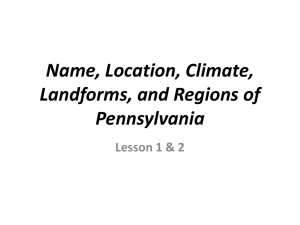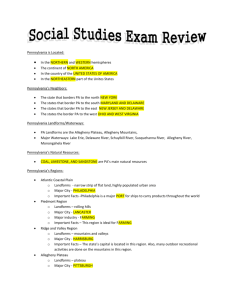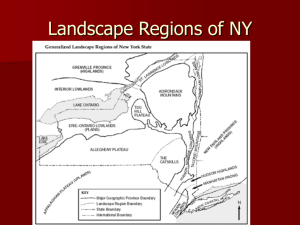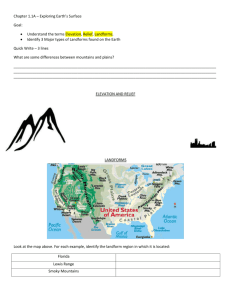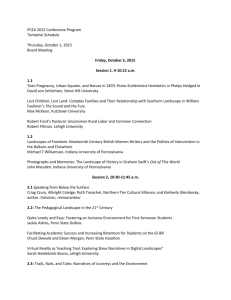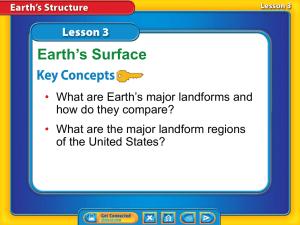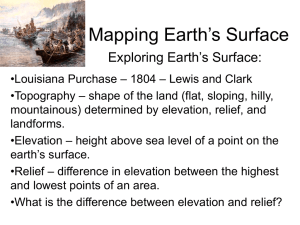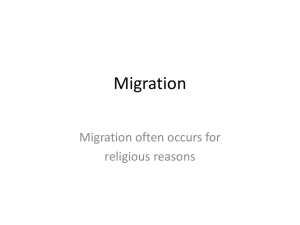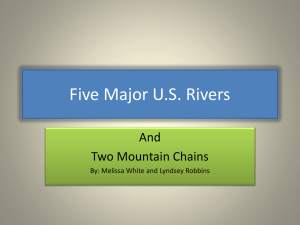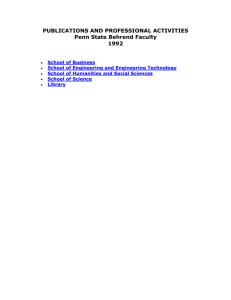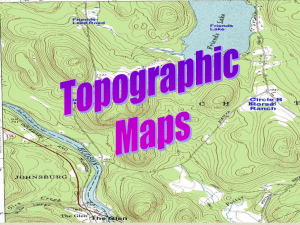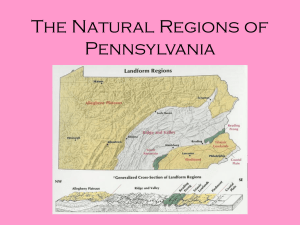PAlesson1
advertisement
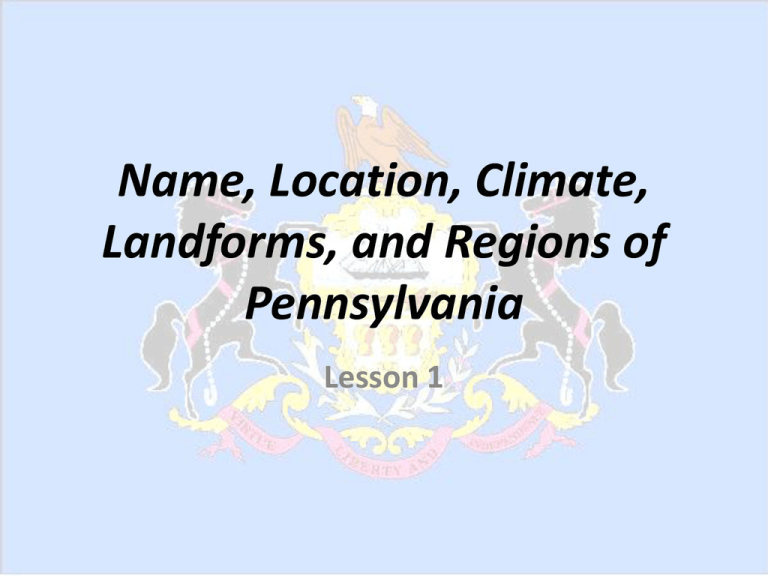
Name, Location, Climate, Landforms, and Regions of Pennsylvania Lesson 1 5 Themes of Geography • 1. Location – location of city or your community • 2. Place – where something is in relation to its surroundings ex. City in contrast to smaller communities • 3. Human-Environment Interaction – how people depend on the environment or change land • 4. Movement – connection between places and patterns of movement • 5. Region – ex. Tourist, political, business, rural, urban, suburban, or even school district Vocabulary – 3 minutes to copy into your notes, leave spaces between words • • • • • • • • • • Square mile Humid continental Nor’easter Drought Lake Effect Regions Landforms Plain Ridge Plateau • • • • • • • • • • Watershed Wetlands Hydroelectric power Natural resource Renewable Non renewable Loam Fossil fuels Anthracite bituminous • 1681 – name of state provided by William Penn and the King of England. – Penn wanted to call colony “Sylvania” (woods) – King added Penn in honor of William’s father • Penn’s woods • Commonwealth – founded for the common good or wealth of its people – Pennsylvania is one of only four states that carry title – Massachusetts, Virginia, and Kentucky View with surrounding states and waterways Location • Pennsylvania is 45,333 square miles – Square mile – a distance calculated by multiplying one mile in width by one mile in length • 302 miles wide and 158 miles length Climate • Humid continental – type of climate that offers four distinct seasons – winter, spring, summer, fall • Adequate rainfall and is suitable for farming • Average temperatures – July – 76 ̊ in southeast, 68 ̊ along Lake Erie – December – 31 ̊ in southeast, 24 ̊ along Lake Erie – Record high – 111 ̊ Record low - -42 ̊ Landforms and Regions • 5 distinctive geographic regions – Regions – Areas which have at least one characteristic – Each region has common landforms and elevations – Landform – land surfaces with natural features such as plains, hills, valleys, mountains, plateaus. 5 Landform Regions of Pennsylvania ← ATLANTIC COASTAL PLAIN Atlantic Coastal Plain • Along Eastern Coast of United States • Elevation ranges from 26 feet above sea level to sea level • Contains the city of Philadelphia PIEDMONT Piedmont • Southeast region between Philadelphia and Harrisburg • Reaches elevation of 600 feet above sea level • Includes some of the most fertile soil in the United States • Allentown, Reading, Lancaster, York • Farms, fields, and forests RIDGE AND VALLEY Ridge and Valley • Hills – land with a rounded elevation • Ridges – a range of hills or mountains • Valleys – long depressions between ranges of hills or mountains • Contains the Appalachian Mountains – mountain chain that runs from Georgia to Maine • Ridges and valleys have individual names • Mt. Davis – state’s highest elevation at 3,213 feet above sea level, located in southern Somerset County • Pennsylvania mountains are low in elevation to other parts of the country ALLEGHENY PLATEAU Allegheny Plateau • Covers 60% of Pennsylvania • Plateau – an elevated section of land that is relatively level in elevation – Elevations range from 700 to 2,500 feet • Pocono Mountains – formed by glacial forces ←ERIE PLAIN Erie Plain • Northwest corner of state along Lake Erie – Only 4 miles wide, stretching from shoreline • Soil is rich in sand and silt • Erie – Pennsylvania’s third largest city Packet Questions • Lesson 1 – questions 1, 4, 5, 6 & 7 • Lesson 2 – questions 1, 3, 4 & 5 • Lesson 3 – questions 2, 3, 5 & 6 • Lesson 4 – questions 2, 4, 5, 6, 8, 9, 10 & 11
